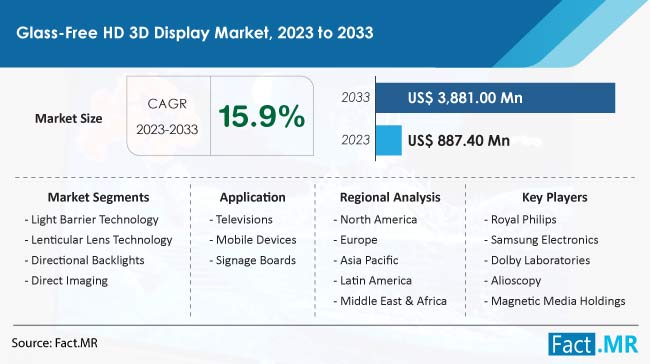Market Overview: The Glass-Free HD 3D Display Market stands at the forefront of technological innovation, offering a captivating visual experience without the need for specialized eyewear or glasses. Glass-free 3D displays utilize advanced technologies to create depth and dimension in images and videos, enhancing user engagement in various applications, from entertainment and gaming to medical visualization and advertising. This market caters to industries seeking immersive and interactive content delivery while minimizing barriers to entry for users.
For More insights into the, Request a Sample of this Report:
https://www.factmr.com/connectus/sample?flag=S&rep_id=286?SR
Market Trends:
- Enhanced User Experience: The market is driven by the trend of enhancing user engagement and experience through immersive 3D visuals that capture attention and elevate content consumption.
- Advancements in Autostereoscopic Technology: Continuous advancements in autostereoscopic technology have led to improved parallax barriers, lenticular lenses, and light field displays, resulting in more realistic and comfortable 3D viewing experiences.
- Integration with Emerging Technologies: Glass-free 3D displays are increasingly integrated with other emerging technologies, such as augmented reality (AR) and virtual reality (VR), creating synergies that further enrich user interactions.
- Industry-Specific Applications: Various industries, including entertainment, healthcare, automotive, and retail, are adopting glass-free 3D displays for specific applications, ranging from 3D movies and medical imaging to in-store advertising.
Competitive Analysis: The Glass-Free HD 3D Display Market features a mix of established tech giants and specialized manufacturers. Companies like Samsung, LG, and Sony leverage their technological expertise and market presence to develop glass-free 3D display solutions that target consumer electronics and entertainment markets.
Specialized manufacturers like Looking Glass Factory and Dimenco focus on providing innovative and tailored glass-free 3D displays for professional and industrial applications. These brands often collaborate with industry-specific partners to deliver customized solutions.
Emerging startups contribute to the market’s diversity by introducing novel technologies and approaches, often focusing on specific use cases that require unique 3D visualization solutions.
Regional Analysis: North America leads the Glass-Free HD 3D Display Market, driven by the presence of major technology companies and a robust entertainment industry. The region’s emphasis on technological innovation and consumer electronics adoption fuels demand.
Europe follows suit, with a strong focus on design, automotive, and medical visualization applications. The market here benefits from collaborations between technology and industry players.
Asia-Pacific showcases potential due to the region’s large consumer electronics market and the increasing adoption of AR and VR technologies. Countries like China, Japan, and South Korea are at the forefront of these developments.
In conclusion, the Glass-Free HD 3D Display Market encapsulates the convergence of technological advancements and enhanced user experiences. As brands compete to deliver immersive, realistic, and comfortable 3D visuals, the market’s trajectory is influenced by industry-specific demands, collaborative efforts, and the continuous evolution of display technologies.
